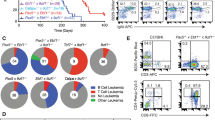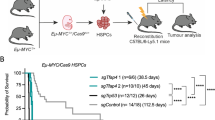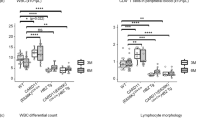Abstract
The TLX1/HOX11 homeobox gene was originally identified at the recurrent t(10;14)(q24;q11) translocation breakpoint, a chromosomal abnormality observed in 5–7% of T-cell acute lymphoblastic leukemias (T-ALLs). Proviral insertional mutagenesis studies performed on transgenic mice ectopically expressing TLX1/HOX11 in B lymphocytes (IgHμ-HOX11Tg mice) revealed the Ubr1 gene locus as a frequent site of proviral insertion, concomitant with accelerated development of diffuse large B-cell lymphoma. Insertion into this genomic region was confirmed by Southern blotting and by the ability to generate a polymerase chain reaction (PCR) amplicon across the viral–genome junction. Western immunoblot and semiquantitative reverse transcriptase–PCR analysis revealed downregulated expression of the Ubr1 gene product subsequent to viral integration. Loss or reduced levels of Ubr1 expression was associated with 5/14 spontaneous B-cell lymphomas in IgHμ-HOX11Tg mice and one of nine primary human T-ALLs. To gain mechanistic insight into the cooperativity between TLX1/HOX11 and Ubr1, IgHμ-HOX11Tg/Ubr1−/− mice were generated. IgHμ-HOX11Tg/Ubr1−/− mice exhibited a modest but statistically significant acceleration of disease onset relative to IgHμ-HOX11Tg/Ubr1+/− mice. Moreover, micronucleus assays to detect for chromosome missegregation were conducted and revealed increased presence of micronuclei in IgHμ-HOX11Tg/Ubr1−/− primary B lymphocyte cultures, and in both TLX1/HOX11-overexpressing T cell lines and fibroblast cultures following transfection with short interfering RNAs (siRNAs) targeting Ubr1. Karyotyping of primary B lymphocyte cultures revealed increased incidences of hypodiploid karyotypes. Finally, mitotic figures analysed from Ubr1 siRNA-transfected fibroblast cultures revealed no defects in chromosome congression to the metaphase plate, but increased incidences of atypical anaphase figures, including the development of anaphase bridges and lagging chromosomes. Based on these findings, we identify a synergistic role between TLX1/HOX11 overexpression and Ubr1 inactivation in promoting chromosome missegregation, permitting the accrual of additional chromosome losses and cytogenic abnormalities en route to malignancy.
This is a preview of subscription content, access via your institution
Access options
Subscribe to this journal
Receive 50 print issues and online access
$259.00 per year
only $5.18 per issue
Buy this article
- Purchase on Springer Link
- Instant access to full article PDF
Prices may be subject to local taxes which are calculated during checkout







Similar content being viewed by others
References
Chen E, Lim MS, Rosic-Kablar S, Liu J, Jolicoeur P, Dube ID et al. (2006). Oncogene 25: 2575–2587.
de Groot RJ, Rumenapf T, Kuhn RJ, Strauss EG, Strauss JH . (1991). Proc Natl Acad Sci USA 88: 8967–8971.
Ditzel M, Wilson R, Tenev T, Zachariou A, Paul A, Deas E et al. (2003). Nat Cell Biol 5: 467–473.
Dubé ID, Kamel-Reid S, Yuan CC, Lu M, Wu X, Corpus G et al. (1991). Blood 78: 2996–3003.
Dubé ID, Raimondi SC, Pi D, Kalousek DK . (1986). Blood 67: 1181–1184.
Hamilton MH, Cook LA, McRackan TR, Schey KL, Hildebrandt JD . (2003). Proc Natl Acad Sci USA 100: 5081–5086.
Hatano M, Roberts CW, Minden M, Crist WM, Korsmeyer SJ . (1991). Science 253: 79–82.
Hawley RG, Fong AZ, Lu M, Hawley TS . (1994). Oncogene 9: 1–12.
Hawley RG, Fong AZ, Reis MD, Zhang N, Lu M, Hawley TS . (1997). Cancer Res 57: 337–345.
Hough MR, Reis MD, Singaraja R, Bryce DM, Kamel-Reid S, Dardick I et al. (1998). Proc Natl Acad Sci USA 95: 13853–13858.
Kawabe T, Muslin AJ, Korsmeyer SJ . (1997). Nature 385: 454–458.
Keller G, Wall C, Fong AZ, Hawley TS, Hawley RG . (1998). Blood 92: 877–887.
Kennedy MA, Gonzalez-Sarmiento R, Kees UR, Lampert F, Dear N, Boehm T et al. (1991). Proc Natl Acad Sci USA 88: 8900–8904.
Klinken SP, Fredrickson TN, Hartley JW, Yetter RA, Morse III HC . (1988). J Immunol 140: 1123–1131.
Kwon YT, Kashina AS, Davydov IV, Hu RG, An JY, Seo JW et al. (2002). Science 297: 96–99.
Kwon YT, Reiss Y, Fried VA, Hershko A, Yoon JK, Gonda DK et al. (1998). Proc Natl Acad Sci USA 95: 7898–7903.
Kwon YT, Xia Z, An JY, Tasaki T, Davydov IV, Seo JW et al. (2003). Mol Cell Biol 23: 8255–8271.
Kwon YT, Xia Z, Davydov IV, Lecker SH, Varshavsky A . (2001). Mol Cell Biol 21: 8007–8021.
Lawson TG, Gronros DL, Evans PE, Bastien MC, Michalewich KM, Clark JK et al. (1999). J Biol Chem 274: 9904–9980.
Morse III HC, Anver MR, Fredrickson TN, Haines DC, Harris AW, Harris NL et al. (2002). Blood 100: 246–258.
Mulder LC, Muesing MA . (2000). J Biol Chem 275: 29749–29753.
Rao H, Uhlmann F, Nasmyth K, Varshavsky A . (2001). Nature 410: 955–959.
Riz I, Hawley RG . (2005). Oncogene 24: 5561–5575.
Tasaki T, Mulder LC, Iwamatsu A, Lee MJ, Davydov IV, Varshavsky A et al. (2005). Mol Cell Biol 25: 7120–7136.
Varshavsky A . (1996). Proc Natl Acad Sci USA 93: 12142–12149.
Yin J, Kwon YT, Varshavsky A, Wang W . (2004). Hum Mol Genet 13: 2421–2430.
Yoshida S, Ito M, Callis J, Nishida I, Watanabe A . (2002). Plant J 32: 129–137.
Acknowledgements
We gratefully acknowledge the assistance of Dr Suzanne Kamel-Reid for providing the primary human T-ALL samples and Ms Gisele Knowles for flow cytometry assistance with the single cell sorts. We acknowledge Dr Jorge Filmus and Dr Alexander Varshavsky for critical evaluation of this manuscript and many helpful discussions. Edwin Chen is an Ontario Graduate Scholar in Science and Technology. This work was supported by funding from the National Cancer Institute of Canada (#13309) to Margaret R Hough, and from the National Institutes of Health (GM69482) to Yong Tae Kwon.
Author information
Authors and Affiliations
Corresponding author
Rights and permissions
About this article
Cite this article
Chen, E., Kwon, Y., Lim, M. et al. Loss of Ubr1 promotes aneuploidy and accelerates B-cell lymphomagenesis in TLX1/HOX11-transgenic mice. Oncogene 25, 5752–5763 (2006). https://doi.org/10.1038/sj.onc.1209573
Received:
Revised:
Accepted:
Published:
Issue Date:
DOI: https://doi.org/10.1038/sj.onc.1209573
Keywords
This article is cited by
-
Physiological functions and clinical implications of the N-end rule pathway
Frontiers of Medicine (2016)
-
Phosphorylation of HOX11/TLX1 on Threonine-247 during mitosis modulates expression of cyclin B1
Molecular Cancer (2010)



